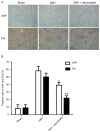Protective effects of atorvastatin on cerebral vessel autoregulation in an experimental rabbit model of subarachnoid hemorrhage
- PMID: 29257200
- PMCID: PMC5780106
- DOI: 10.3892/mmr.2017.8074
Protective effects of atorvastatin on cerebral vessel autoregulation in an experimental rabbit model of subarachnoid hemorrhage
Erratum in
-
[Corrigendum] Protective effects of atorvastatin on cerebral vessel autoregulation in an experimental rabbit model of subarachnoid hemorrhage.Mol Med Rep. 2025 Nov;32(5):308. doi: 10.3892/mmr.2025.13673. Epub 2025 Sep 5. Mol Med Rep. 2025. PMID: 40910277 Free PMC article.
Abstract
The aim of the present study was to assess the therapeutic effects of atorvastatin on cerebral vessel autoregulation and to explore the underlying mechanisms in a rabbit model of subarachnoid hemorrhage (SAH). A total of 48 healthy male New Zealand rabbits (weight, 2‑2.5 kg) were randomly allocated into SAH, Sham or SAH + atorvastatin groups (n=16/group). The Sham group received 20 mg/kg/d saline solution, whereas 20 mg/kg/d atorvastatin was administered to rabbits in the SAH + atorvastatin group following SAH induction. Changes in diameter, perimeter and basilar artery (BA) area were assessed and expression levels of the vasoactive molecules endothelin‑1 (ET‑1), von Willebrand factor (vWF) and thrombomodulin (TM) were measured. Neuronal apoptosis was analyzed 72 h following SAH by terminal deoxynucleotidyl-transferase‑mediated dUTP nick‑end labeling (TUNEL) staining. The mortality rate in the SAH group was 18.75, 25% in the SAH + atorvastatin treated group and 0% in the Sham group (n=16/group). The neurological score in the SAH + atorvastatin group was 1.75±0.68, which was significantly higher compared with the Sham group (0.38±0.49; P<0.05). The BA area in the SAH + atorvastatin group (89.6±9.11) was significantly lower compared with the SAH group (115.4±11.0; P<0.01). The present study demonstrated that SAH induction resulted in a significant increase in the diameter, perimeter and cross‑sectional area of the BA in the SAH + atorvastatin group. Administration of atorvastatin may significantly downregulate the expression levels of ET‑1, vWF and TM (all P<0.01) vs. sham and SAH groups. TUNEL staining demonstrated that neuronal apoptosis was remarkably reduced in the hippocampus of SAH rabbits following treatment with atorvastatin (P<0.05). Atorvastatin treatment may alleviate cerebral vasospasm and mediate structural and functional remodeling of vascular endothelial cells, in addition to promoting anti‑apoptotic signaling. These results provided supporting evidence for the use of atorvastatin as an effective and well‑tolerated treatment for SAH in various clinical settings and may protect the autoregulation of cerebral vessels.
Figures







References
MeSH terms
Substances
LinkOut - more resources
Full Text Sources
Other Literature Sources
Miscellaneous

